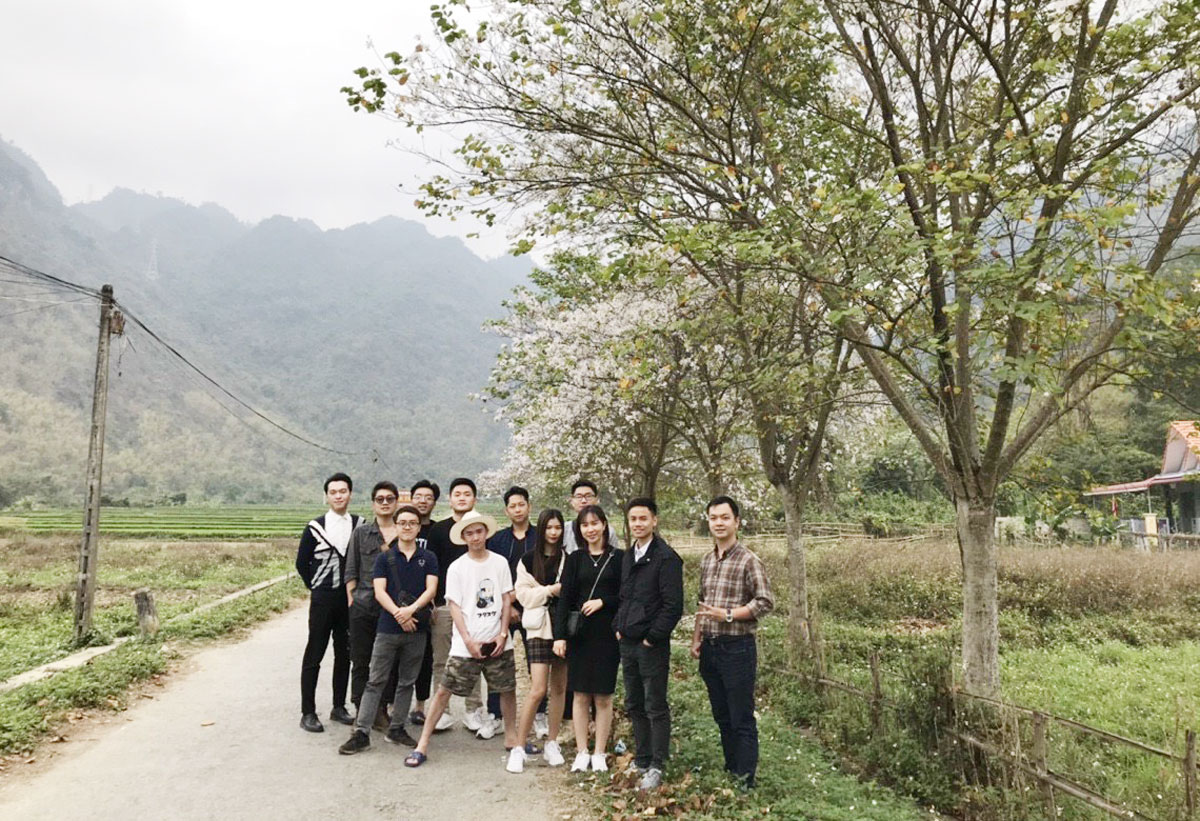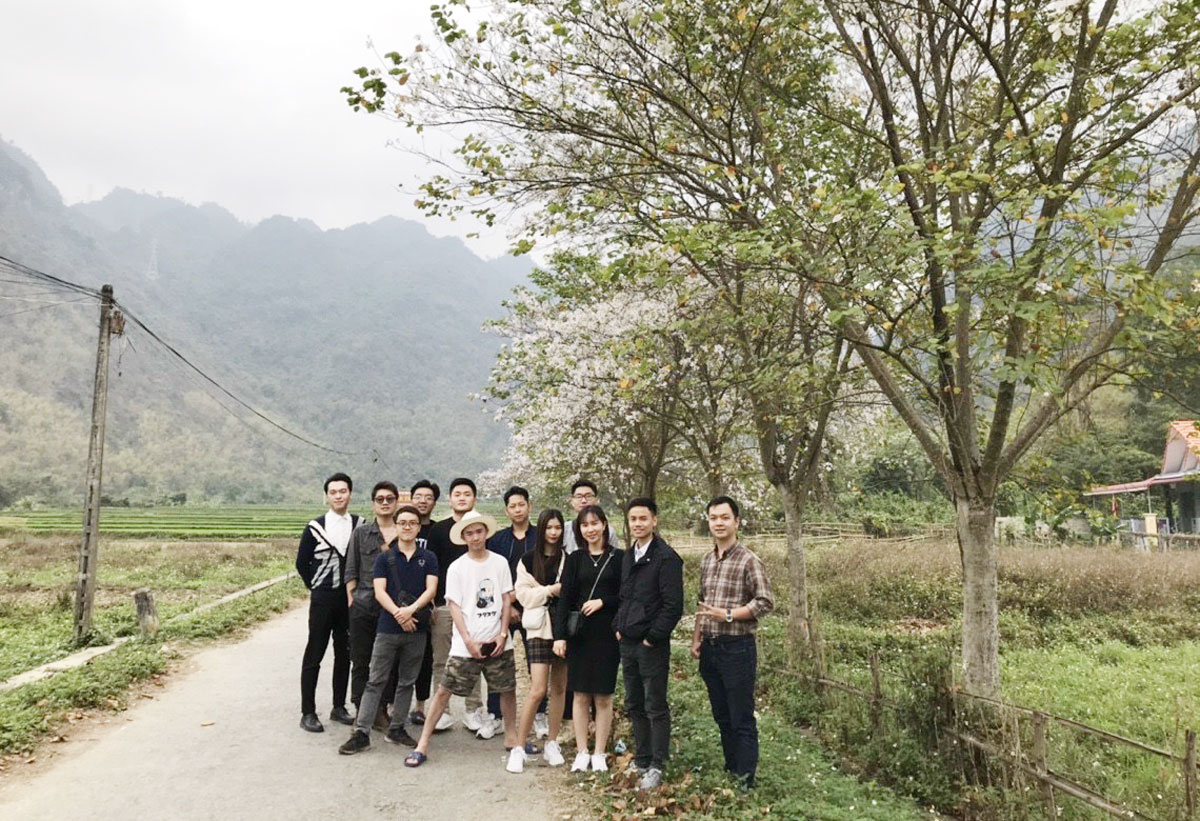
(HBO) – With beautiful landscapes and unique culture of the Thai ethnic minority group, Mai Chau district in Hoa Binh province is an ideal choice for tourists in March when the region is shrouded in the whiteness of blooming Ban (bauhinia) flowers.
 Visitors take photos with Ban
flowers in Van village of Mai Chau town (Mai Chau district).
Visitors take photos with Ban
flowers in Van village of Mai Chau town (Mai Chau district).
February and March is the blossoming peak
of Ban flowers. The road to Mai Chau
valley winds through fruit-laden trees in orange farms in Cao Phong and pomelo
orchards in Tan Lac.
From the peak of Thung Khe, the Mai Chau
valley looks like a beautiful girl wearing a green dress with white flowers on
it. Ban flowers blossom on the top of mountains, on cliffs, family’s gardens,
and along roads. The road from Tong Dau commune leading to the centre of the
district is lined by Ban trees which have shed most of their leaves to show off
their flowers. Looking closer, full-blossom flowers are like flying butterflies.
Some flowers have a purple petal among white ones, some have a light pink
petal. The Ban leaves are shaped like horseshoe, but many Thai girls like to
think that they have the shape of double hearts.
Kha Thi Tuyet, a Thai girl from Mai Chau
town told us the local story about Ban flower. The story has it that a
beautiful girl named Ban and a smart man named Khum were in love with each
other. Unfortunately, Ban’s parents did not accept their love because Khum was
poor. Failing to persuade her parents, the girl left her home on a Spring
morning to look for her lover. She went and went deep into the forest, and
finally collapsed and died. In the spot where she died, trees grew with thousands
of flowers, the petals of which look like the girl’s beautiful hands. Khum came
to the place but all he could find was Ban’s head scarf. He desperately called
her name until he died and became a bird named Loc Khum. Since then, when spring
comes, white Ban flowers blossom across the forest, while Loc Khum birds keep
on singing like the voice of the man calling his lover throughout the Ban
flower season.
There is another story about the flower,
which says the flowers have their origin in the white cloth that local people
tied on trees in mourning of local insurgents fighting against evil and
oppressing forces./.
Spanning thousands of hectares and winding gracefully along mountain slopes, hillsides, and riverbanks, the terraced rice fields of Lac Son District present a stunning and captivating beauty. This region, renowned for its remarkable terraced landscapes, is also the centre of Hoa Binh Culture known for numerous archaeological sites.
The life of Mong people in Hang Kia and Pa Co communes of Mai Chau district has improved much thanks to tourism development.
The man-made Hoa Binh Lake, with a water surface area of approximately 9,000 hectares and a capacity of 9.45 billion cubic meters, stretches over 200 kilometers from Hoa Binh to Son La provinces. With the goal of developing into a national tourism area, the Hoa Binh Lake tourism area is expected to not only become the largest tourism centre in the province but also one of the 12 key tourist destinations in the northern midland and mountainous region of Vietnam.
Da Bia hamlet, now Duc Phong, in Tien Phong commune, Da Bac district, was once almost isolated from the outside as the only way to the hamlet was to get a boat ride across the Hoa Binh reservoir. However, as its tourism potential has been unleashed, the hamlet has established itself as one of the most attractive destinations on the tourism map. It has even received the ASEAN Community-Based Tourism Awards in 2019.
In the first 9 months of 2024, Mai Chau district, Hoa Binh province welcomed over 684 thousand visitors to visit and relax. In which, over 516 thousand domestic visitors and more than 168 thousand international visitors. Total revenue from tourism is estimated at over 821 billion VND.
Da Bac district, bestowed with stunning landscapes, is developing ecological and resort tourism offerings. Several tourist sites, put into operation this year, has attracted throngs of high-spending and young domestic visitors.



 Visitors take photos with Ban
flowers in Van village of Mai Chau town (Mai Chau district).
Visitors take photos with Ban
flowers in Van village of Mai Chau town (Mai Chau district).